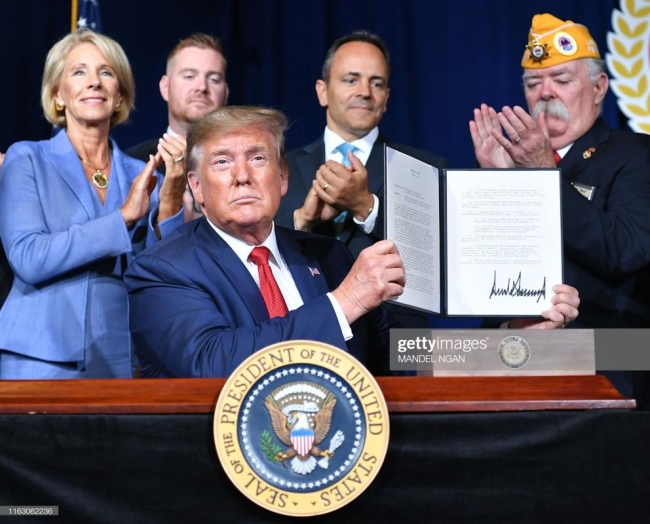You have /5 articles left.
Sign up for a free account or log in.

President Trump after signing a presidential memorandum on discharging the federal student loan debt of disabled veterans last August.
Getty Images/Mandel Ngan
The federal government plans to forgive hundreds of millions of dollars in outstanding loan debt for roughly 25,000 disabled veterans in July. But while consumer and veterans’ groups are applauding the move by the U.S. Department of Education, they also don’t think it goes far enough.
They want the department to discharge the student loans of nearly 400,000 other borrowers who have also been deemed too disabled to work by the federal government but don’t qualify for the relief either because they are not veterans or because their injuries were not service related.
Meanwhile, the Democratic chairman of the U.S. House education committee is also criticizing the department for not going further.
“Unfortunately, students with permanent disabilities -- who are entitled to debt relief -- are trapped in a bureaucratic web,” Representative Bobby Scott of Virginia said in a statement Friday. “The Education Department has the ability to implement automatic discharge of these loans. The department should use its power to give these hundreds of thousands of students the relief they deserve.”
The question of how far the Trump administration should go to forgive the debt of those who are too disabled to work comes after the department has tried to address why only a small percentage of disabled veterans have had their loans discharged, which they are entitled to under the Higher Education Act, the law that governs federal student aid.
As an initial step, the U.S. Department of Veterans Affairs in 2018 began sharing the names of veterans who qualify for the help with the Education Department, which then contacted the borrowers. That led to about 22,000 more veterans getting relief, to the tune of more than $650 million in discharges, according to the department.
But 25,000 more disabled veterans who are entitled to the help still have been left with $168 million in outstanding loans, said the National Consumer Law Center. The problem was that even with more coordination with the VA, veterans were still required to apply for their loans to be dismissed, according to veterans’ and consumer groups. But many still didn’t know they could get the loans discharged.
They might have received a letter from the Education Department saying they were entitled to the relief, said Abby Shafroth, a staff attorney for the NCLC. But “they might be blind and not able to read the letter. They might have dementia,” she said.
So in another step, President Trump in August signed an executive order to simply discharge the loans of all those deemed as eligible by the VA without requiring them to apply. That's expected to start in July, according to interim rules the department released last November to carry out the order. Discharging the veterans' loans would cost $1.3 billion over the next decade, according to the interim rules, between eliminating current loans and discharging others as more borrowers become disabled.
“The department’s interim final regulations are a common-sense solution to ensuring that veterans get the relief they deserve without jumping through confusing, time-consuming and unnecessary bureaucratic hurdles,” the NCLC, the National Student Legal Defense Network and the Institute for College Access and Success, wrote in a joint letter to the department last week. Veterans Education Success and 21 other veterans’ groups also praised the change in a separate letter.
However, the change also raised the question of why the department does not forgive the loans of others who are too disabled to work. According to Education Department numbers reported by National Public Radio last December, more than 375,000 additional borrowers, who have been deemed disabled by the Social Security Administration, wouldn’t qualify for the automatic discharge.
“We are disappointed that the interim final regulations only extend the automatic discharge system to a small subset of [disabled] borrowers,” NCLC and the two other consumer groups wrote in their letter.
Those still owing money face the same problems as the veterans -- they still have to apply for the discharges. But, the letter said, “like veterans, many Social Security Disability Insurance (SSDI) and Supplemental Security Income (SSI) recipients who qualify for loan cancellation are simply unaware of the discharge program. According to the NPR report, only one-third of matched eligible borrowers had even applied for loan discharge."
Many of those borrowers are not veterans. But some are veterans who became disabled after they left the military, or whose injuries were not considered service related even though they were on active duty, said Mike Saunders, legal director for Veterans Education Success. While veterans’ groups did not raise the issue in their letter, Saunders said those veterans also should have their loans discharged.
“We shouldn’t just forget about them,” he said.
Angela Morabito, an Education Department spokeswoman, declined comment while the department is still working on the final rules needed to automatically discharge the loans.




